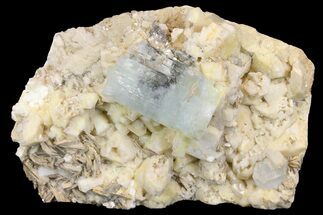This Specimen has been sold.
1.75" Emerald in Calcite - Khaltoru Mine, Pakistan
This is a 1.75" wide specimen that contains an association of emerald in a mass of calcite. It was collected from the Khaltoru Mine in northern Pakistan.
Beryl is a mineral composed of beryllium aluminum cyclosilicate, with the chemical formula Be3Al2(SiO3)6. Naturally occurring beryl tends to form hexagonal crystals that can reach several meters in size if given the right conditions. Completely pure beryl (goshenite) will be transparent and colorless, while mineral impurities frequently tint the crystals color in most specimens.
Well known varieties of beryl include aquamarine and emerald, although beryl can also be colorless, yellow, white, and red, depending on the incorporated impurities during formation. Red beryl is its rarest form, and can currently only be found in New Mexico and Utah.
Well known varieties of beryl include aquamarine and emerald, although beryl can also be colorless, yellow, white, and red, depending on the incorporated impurities during formation. Red beryl is its rarest form, and can currently only be found in New Mexico and Utah.
About Calcite Crystals
Calcite crystals are a form of calcium carbonate (CaCO₃) known for their diverse shapes, transparency, and vibrant range of colors. They typically form in rhombohedral, scalenohedral, or prismatic shapes, often with well-defined, sharp edges and glossy surfaces. Calcite crystals are often translucent or transparent, sometimes displaying a double refraction effect where objects viewed through the crystal appear doubled. They can appear in various colors—white, clear, yellow, pink, blue, green, and orange—depending on impurities or trace minerals.
A notable characteristic of calcite is its reaction with weak acids like vinegar, which causes it to effervesce, or fizz, as it releases carbon dioxide. This property makes calcite crystals a key tool in geological identification and studies. Calcite forms in many environments, from sedimentary rocks like limestone and marble to hydrothermal veins.
Calcite crystals are a form of calcium carbonate (CaCO₃) known for their diverse shapes, transparency, and vibrant range of colors. They typically form in rhombohedral, scalenohedral, or prismatic shapes, often with well-defined, sharp edges and glossy surfaces. Calcite crystals are often translucent or transparent, sometimes displaying a double refraction effect where objects viewed through the crystal appear doubled. They can appear in various colors—white, clear, yellow, pink, blue, green, and orange—depending on impurities or trace minerals.
A notable characteristic of calcite is its reaction with weak acids like vinegar, which causes it to effervesce, or fizz, as it releases carbon dioxide. This property makes calcite crystals a key tool in geological identification and studies. Calcite forms in many environments, from sedimentary rocks like limestone and marble to hydrothermal veins.
SPECIES
Beryl var. Emerald & Calcite
LOCATION
Khaltoru Mine, Northern Pakistan
SIZE
specimen is 1.75" wide
CATEGORY
ITEM
#112078
 Reviews
Reviews












